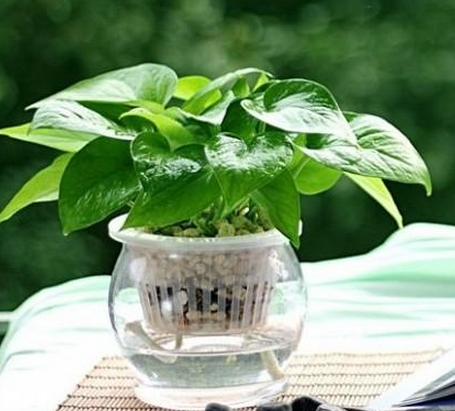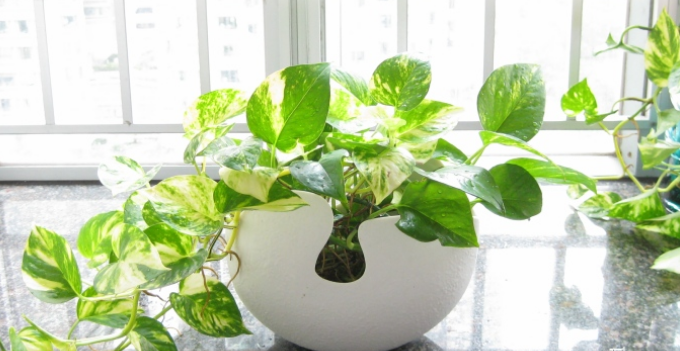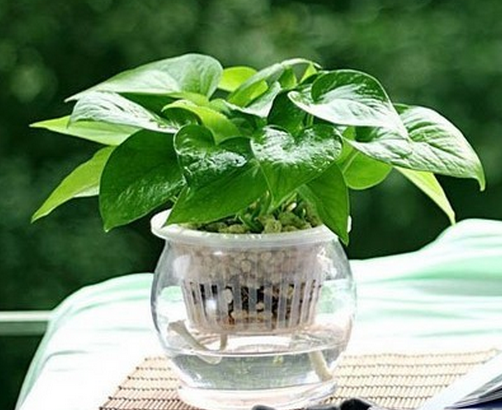Seven methods of hydroponic green pineapple culture
Hydroponic green pineapple, that is, green pineapple cultivated by hydroponic method. Green pineapple, a large evergreen vine. Growing in the tropics, it often climbs on the rocks and tree trunks of the rainforest and can grow into giant lianas. Its entanglement is strong and the air root is well developed. it can not only be attached to the column tied up with brown, placed in the foyer and hotel, but also can be cultivated into a hanging shape in the study and windowsill, which is a kind of flower which is more suitable for indoor display. So what are the methods of hydroponic green pineapple culture? Next, let the editor who decorates the network give you a brief introduction.

Seven methods of hydroponic green pineapple culture
1. Selection of hydroponic containers.
You can choose vases, beakers and other transparent containers (such as glass bottles).
2. The choice of water use
Water is the key element of hydroponic green pineapple, tap water, well water, clean drinking water and so on can be used, but it should be placed for a day or two before use.
3. Cutting method
The healthy and strong green radish stem with aerial root should be selected as the object of hydroponic culture, the length of the branch is 15cm~30cm, and the leaves of the basic 1-2 nodes can be removed and put into water; the potted plants with better plant type can also be selected to wash the soil on the roots and cut off the excess old roots and put them into clean water.
4. Water change cycle
In the initial stage of hydroponic culture, the water should be changed frequently, every 2-3 days and 7-10 days after rooting. Hydroponic culture solution can be purchased for anti-inflammation and sterilization to promote root growth.
5. Root pruning
If the root system is too long, it should be cut short in time to prevent nutrition loss. If the root system is rotten and sticky, it should be cleaned in time, cut off the rotten root, and soaked and disinfected with potassium permanganate solution before restoration. The water should be changed according to the initial stage of hydroponics.
6. Temperature and light
In winter in the north, the room temperature is more than 10 ℃, which can pass the winter safely, and only when it is more than 20 ℃ can it grow normally. At the same time, attention should be paid to avoid excessive temperature difference and should not be close to heating equipment. Hydroponic green pineapple needs sufficient scattered light to make the leaves stretch and the color is green. It should be placed where the scattered light is sufficient, such as a sealed balcony with light and a place with good indoor light.
7. Humidity
There are several ways to increase humidity: close to the humidifier, spray leaves, stems and air roots with sprayers, gently wipe the leaves with cold wet towels or toilet paper, and spray water to the growth of aerial roots.
Culture method and picture appreciation of hydrangea
Hydrangea is planted in modern parks and scenic spots to form a beautiful landscape. However, the potted ornamental of hydrangea is not very common, which brings excellent opportunities for the development and application of hydrangea. We might as well hurriedly learn the breeding method of hydrangea and walk at the front end of hydrangea culture.
The culture method and picture appreciation of Hydrangea
[plant archives]-
English name: Hydrangea
Scientific name: Hydrangea macrophylla
Aliases: eight Immortals, Ziyang Flower, Seven changes, Hydrangea, Noodle Flower
Family: Saxifragaceae of Saxifragaceae
Genus: Hydrangea Hydrangea
Distribution of origin: originated in Sichuan and Japan
Morphological features: deciduous shrubs or small trees, leaves opposite, ovate to ovate-elliptic, surface dark green, summer flowering, integrated large globose Cymes at the top of branches, margin with white neutral flowers. The flowering period is from April to May and the flower diameter is 18-20 cm, all of which are sterile flowers. The flowers bloom greenish at first, then turn white with fragrance. It is named because its shape is like hydrangea.
The growth habits of Hydrangea-
We must first understand the growth habits of hydrangea before we can pertinently master the breeding methods of hydrangea. Hydrangea is native to the Yangtze River Basin in China and is fond of warm, moist and semi-shady environment. Afraid of drought and waterlogging, it is not cold-resistant. In cold areas, the aboveground parts wither and die in winter, and new shoots will not sprout again until the next spring. Hydrangea likes the light loam which is fat, moist and well drained, and has strong adaptability. The acidity and basicity of the soil had a great influence on the flower color of hydrangea, which was blue in acidic soil and red in alkaline soil.
The culture method of hydrangea-
The optimum temperature for the growth of ★ hydrangea is 18-28 ℃, and the winter temperature is not lower than 5 ℃. Flower bud differentiation should be maintained under the condition of 5-7 ℃ for 6-8 weeks. 20 ℃ could promote its flowering, and if it could maintain 16 ℃ after flowering, the flowering period could be prolonged.
★ Hydrangea is a short-day plant, which is treated in the dark for more than 10 hours every day and forms flower buds in about 45-50 days.
★ potted hydrangea is commonly used in 15-20 cm pots, which are fully watered after sprouting in spring to ensure that the leaves do not wither. June-July is the florescence of hydrangea, fertilizer and water should be adequate, fertilizing once every semimonthly.
The cultivation of hydrangea in ★ should avoid the hot sun, and 60-70% shading is the most ideal. When the light is too strong in midsummer, proper shading can prolong the flowering period. Removing the flower stem after flowering can promote the formation of new branches.
★ hydrangea pot soil should be kept moist, but watering should not be too much, especially in the rainy season to pay attention to drainage to prevent rotting roots caused by waterlogging. It is better to be a little dry in winter, and the leaves are perishable if they are too wet. Change the basin every spring and trim it properly in order to keep the plant shape beautiful.
The main diseases of ★ hydrangea are wilt, powdery mildew and leaf spot. Spray control with 65% Dysen zinc wettable powder 600 times solution. Insect pests are harmful to aphids and bug bugs and can be sprayed with 1500 times of omethoate EC.
Conclusion: hydrangea is rich in Japan. There are many varieties of hydrangea in horticultural shops, and many new varieties of hydrangea with strange colors can be seen, all of which are watched as family potted plants. Hydrangea culture is the trend of the times, quickly grasp the method of hydrangea culture.
[more Encyclopedia of plants]
Poppy evening incense rose rhododendron lavender green pineapple bamboo bean valve green hyacinth crane cherry calla
African jasmine rose spring festival flower succulent plant tropical plant tequila canna forget-me-not dandelion
Taxus chinensis var. mairei cotton sweet-scented osmanthus flower hydroponics plant home fengshui plant bedroom fengshui plant plum blossom aloe
Jasmine radiation protection plant Tongqian grass potted bonsai making drug plant mistletoe indoor flower rich tree evergreen rich bamboo
Potted anthurium mint stone flower geranium garden crab claw orchid plain sailing Kunlun snow chrysanthemum water lily blue witch
Culture method and picture appreciation of hydrangea
Hydrangea is planted in modern parks and scenic spots to form a beautiful landscape. However, the potted ornamental of hydrangea is not very common, which brings excellent opportunities for the development and application of hydrangea. We might as well hurriedly learn the breeding method of hydrangea and walk at the front end of hydrangea culture.
[recommended reading] Lily longevity flower thousand-day red gardenia, gentleman orchid Hongyun, Platycodon grandiflorum, mulberry, primrose, mimosa
The culture method and picture appreciation of Hydrangea
[plant archives]-
English name: Hydrangea
Scientific name: Hydrangea macrophylla
Aliases: eight Immortals, Ziyang Flower, Seven changes, Hydrangea, Noodle Flower
Family: Saxifragaceae of Saxifragaceae
Genus: Hydrangea Hydrangea
Distribution of origin: originated in Sichuan and Japan
Morphological features: deciduous shrubs or small trees, leaves opposite, ovate to ovate-elliptic, surface dark green, summer flowering, integrated large globose Cymes at the top of branches, margin with white neutral flowers. The flowering period is from April to May and the flower diameter is 18-20 cm, all of which are sterile flowers. The flowers bloom greenish at first, then turn white with fragrance. It is named because its shape is like hydrangea.
The growth habits of Hydrangea-
We must first understand the growth habits of hydrangea before we can pertinently master the breeding methods of hydrangea. Hydrangea is native to the Yangtze River Basin in China and is fond of warm, moist and semi-shady environment. Afraid of drought and waterlogging, it is not cold-resistant. In cold areas, the aboveground parts wither and die in winter, and new shoots will not sprout again until the next spring. Hydrangea likes the light loam which is fat, moist and well drained, and has strong adaptability. The acidity and basicity of the soil had a great influence on the flower color of hydrangea, which was blue in acidic soil and red in alkaline soil.
The culture method of hydrangea-
The optimum temperature for the growth of ★ hydrangea is 18-28 ℃, and the winter temperature is not lower than 5 ℃. Flower bud differentiation should be maintained under the condition of 5-7 ℃ for 6-8 weeks. 20 ℃ could promote its flowering, and if it could maintain 16 ℃ after flowering, the flowering period could be prolonged.
★ Hydrangea is a short-day plant, which is treated in the dark for more than 10 hours every day and forms flower buds in about 45-50 days.
★ potted hydrangea is commonly used in 15-20 cm pots, which are fully watered after sprouting in spring to ensure that the leaves do not wither. June-July is the florescence of hydrangea, fertilizer and water should be adequate, fertilizing once every semimonthly.
The cultivation of hydrangea in ★ should avoid the hot sun, and 60-70% shading is the most ideal. When the light is too strong in midsummer, proper shading can prolong the flowering period. Removing the flower stem after flowering can promote the formation of new branches.
★ hydrangea pot soil should be kept moist, but watering should not be too much, especially in the rainy season to pay attention to drainage to prevent rotting roots caused by waterlogging. It is better to be a little dry in winter, and the leaves are perishable if they are too wet. Change the basin every spring and trim it properly in order to keep the plant shape beautiful.
The main diseases of ★ hydrangea are wilt, powdery mildew and leaf spot. Spray control with 65% Dysen zinc wettable powder 600 times solution. Insect pests are harmful to aphids and bug bugs and can be sprayed with 1500 times of omethoate EC.
Conclusion: hydrangea is rich in Japan. There are many varieties of hydrangea in horticultural shops, and many new varieties of hydrangea with strange colors can be seen, all of which are watched as family potted plants. Hydrangea culture is the trend of the times, quickly grasp the method of hydrangea culture.
[more Encyclopedia of plants]
Poppy evening primrose rhododendron lavender green raven bamboo pea green hyacinth red crane cherry calla
African jasmine rose flowers spring festival flowers succulent plants tropical plants tequila canna other shore flowers forget-me-not dandelions
Taxus chinensis var. mairei cotton sweet-scented osmanthus flower hydroponic plant home fengshui plant bedroom fengshui plant plum blossom aloe
Jasmine radiation protection plant Tongqian potted bonsai making drug plant mistletoe indoor flower rich tree evergreen rich bamboo
Potted production of Anthurium andraeanum mint raw stone flower geranium garden crab claw orchid plain sailing tiger skin orchid Kunlun snow chrysanthemum water lily blue witch
- Prev

What are the functions of culturing green pineapple
Green pineapple, also known as devil vine, citrus fruit, bamboo leaf grass, golden kudzu, golden vine and so on, is a kind of plant that is easy to feed, as long as there is water, it is called "flower of life". Home life, may raise some flowers and plants, increase beauty, now many families are breeding green pineapple
- Next

What are the points for attention in hydroponic green pineapple culture
Hydroponic green pineapple is one of the very good indoor decoration hydroponic plants, climbing vine foliage flowers. The stem of the radish is soft and the leaves are delicate. Set a basin high on the top of the cabinet of the furniture, let its vine stem droop calmly, or hang into a circle after the vine stem is too long, just like a green relief. So what are the points for attention in hydroponic green pineapple culture?
Related
- Fuxing push coffee new agricultural production and marketing class: lack of small-scale processing plants
- Jujube rice field leisure farm deep ploughing Yilan for five years to create a space for organic food and play
- Nongyu Farm-A trial of organic papaya for brave women with advanced technology
- Four points for attention in the prevention and control of diseases and insect pests of edible fungi
- How to add nutrient solution to Edible Fungi
- Is there any good way to control edible fungus mites?
- Open Inoculation Technology of Edible Fungi
- Is there any clever way to use fertilizer for edible fungus in winter?
- What agents are used to kill the pathogens of edible fungi in the mushroom shed?
- Rapid drying of Edible Fungi

